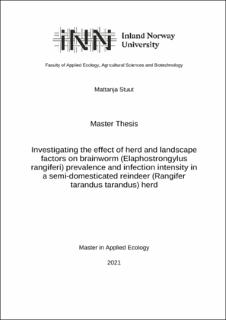| dc.description.abstract | The increasing concern about brainworm (Elaphostrongylus rangiferi) in reindeer (Rangifer tarandus) is driven by climate change. The development of the nematode in its intermediate host – gastropods – is strongly affected by temperature and accelerates with increasing temperatures. Warmer summers therefore result in an increased risk of large disease outbreaks. Whilst there have been a number of studies looking at wild tundra reindeer in southern Norway, there have been no systematic studies of brainworm infections and landscape use in the semi-domesticated reindeer herds bordering these wild reindeer populations. More knowledge about brainworm and the environmental factors involved in its lifecycle is needed to better help herders in developing brainworm management strategies. I hypothesized that brainworm infection prevalence and intensity is not only age- and sex-related but also affected by landscape use of the reindeer, as this determines the measure of intake of brainworminfected gastropods. Data includes faecal samples from GPS-collared semi-domesticated reindeer in central Norway, taken in winter 2019-2021 as well as in summer and autumn 2020. Faeces were analysed using the Baermann method to count brainworm larval intensity. Landscape use of the reindeer was analysed using GPS data of collared reindeer and vegetation maps. During autumn 2020, I conducted gastropod sampling by visually searching plots for gastropods inside the reindeer grazing areas and these results were integrated in the landscape analysis. Results of faecal analysis show patterns in which infections in all age-classes increase as the year progresses, which corresponds to literature describing the duration of the migratory life cycle of brainworm parasites. Probability of infection and infection intensity decreased with increasing body weight for calves and adult females, which is in contrast with previous literature and may be a sign of brainworm having a sub-clinical impact with reduced weight gain or weight loss in individuals with a high level of infection. Landscape use analysis showed trends in which the availability of, and time spent in, bogs had a positive effect on the infection intensity, whereas increasing altitude lead to a decrease in brainworm infection intensity. However, since the significance level was not reached for these relationships, more research is needed to confirm these trends. | en_US |
